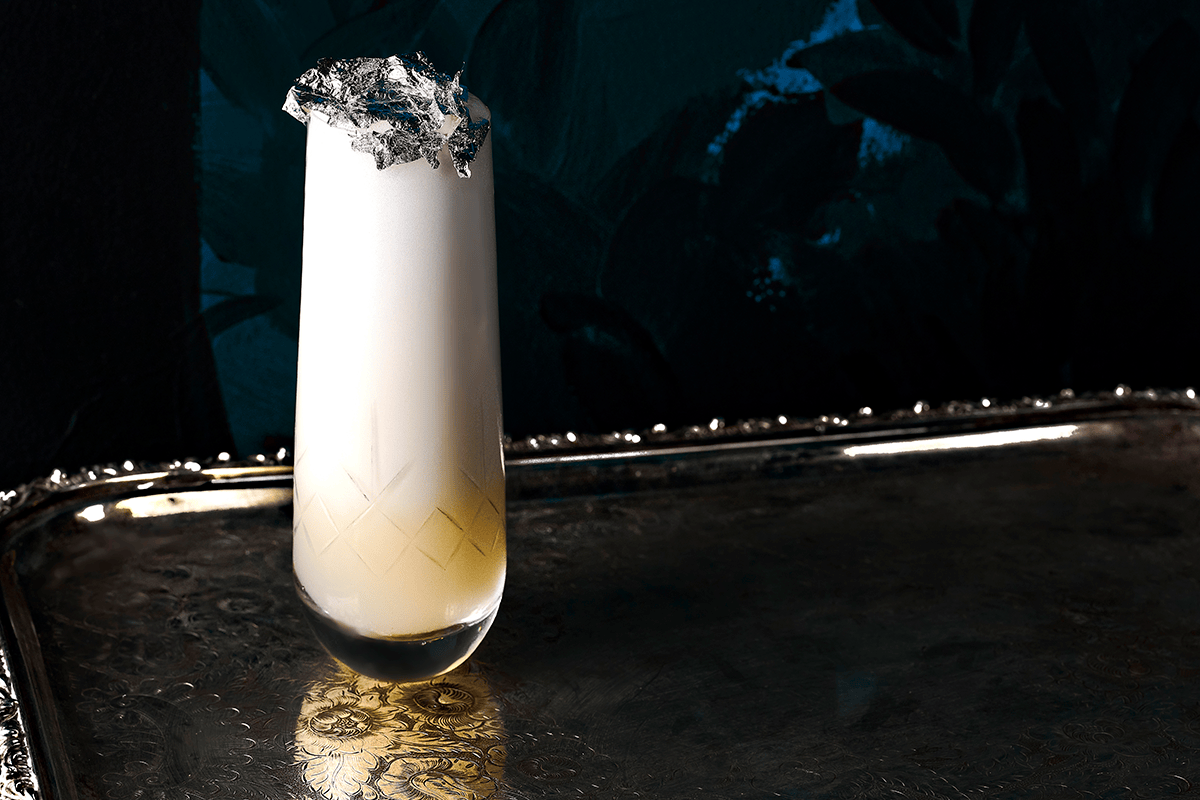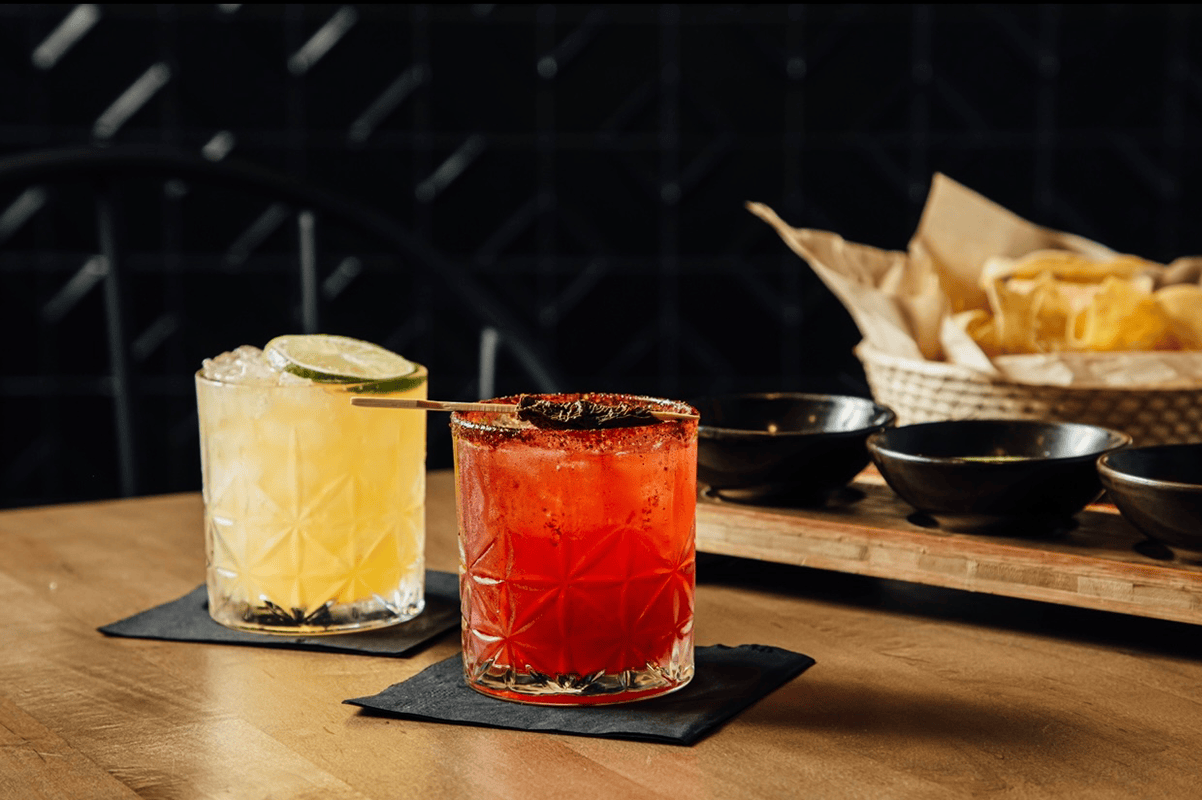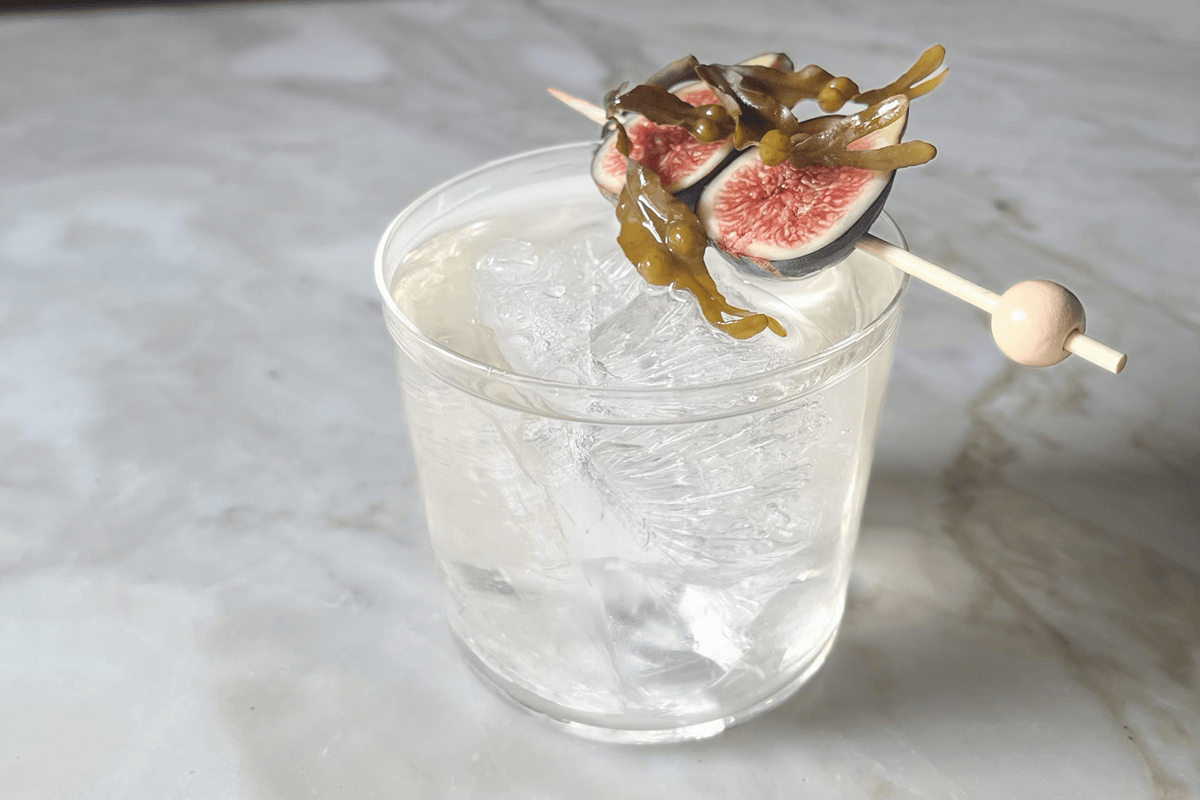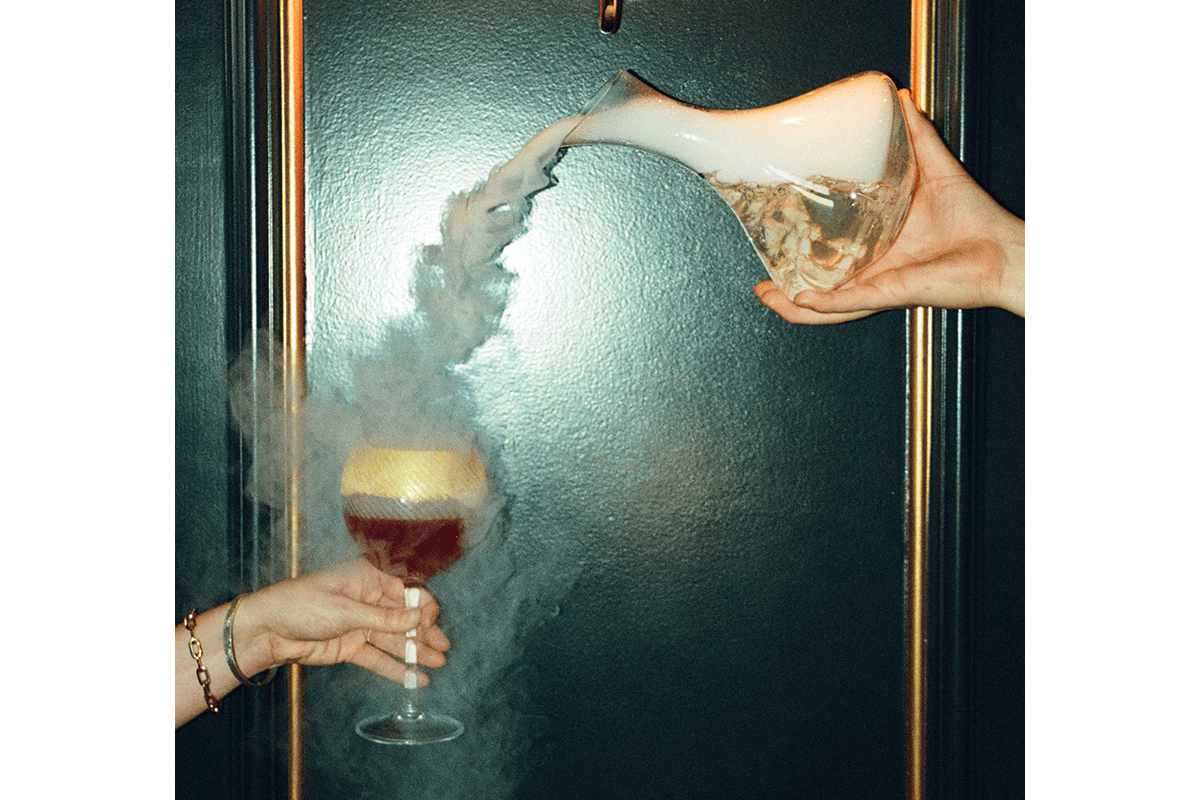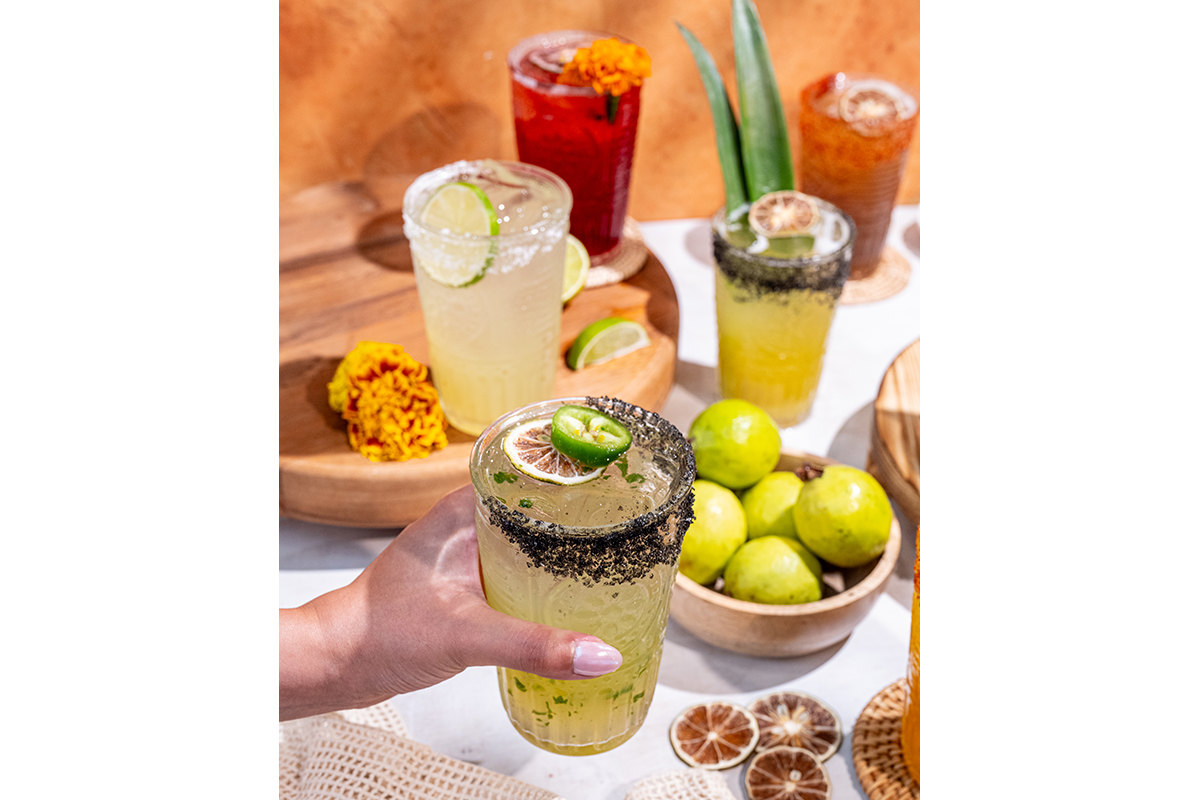Turning Cocktails Into Mini Works of Art
How clever garnishes and high-impact finishes elevate the modern beverage menu
Turning Cocktails Into Mini Works of Art
How clever garnishes and high-impact finishes elevate the modern beverage menu
By Mike Kostyo
April 10, 2024
By Mike Kostyo
April 10, 2024
When the team at San Francisco’s Beacon Grand Hotel decided to reopen the Starlite (née Starlight), a renowned cocktail bar on the building’s 21st floor that had shuttered in 2022, adding the Cable Car to the menu was a no-brainer. A signature at the swanky lounge, the drink was first developed by bartender Tony Abou-Ganim as a riff on the sidecar, swapping the traditional cognac for spiced rum and adding cinnamon to the sugar rim. Those simple changes were enough to drive the drink’s popularity well beyond San Francisco—in 2020, digital media brand Punch heralded it a “modern classic.”
But when award-winning bartender Scott Baird, a co-owner of the city’s Trick Dog, took on the new iteration’s updated menu, he had to up his game. Cocktails these days are miniature works of art, after all, showcasing multiple layers of flavor, a rainbow of eye-catching colors and a range of innovative garnishes and finishes that demand attention when the drink hits the bar. Enter the Cable Car Redux, which adds Chinese five-spice syrup (an homage to San Francisco’s Chinatown) and gold to the cinnamon-sugar rim. It’s all finished with “Karl the Fog,” the name given to the Bay Area’s infamous fog, which in this case is a tableside pour of dry ice “fog,” scented like the California coast, with cypress, eucalyptus and redwood oils.
Baird isn’t alone when it comes to introducing high-impact finishes to his drinks. At a time when the local bar is serving up creative twists on garnishes and smoke bubbles can be found on cruise ship cocktails, bartenders are topping tipples with ever-more innovative garnishes. These final flourishes go a long way in earning the rising prices for modern cocktails (the Cable Car Redux is $22), while also lending themselves to the all-important social media post.
Flowers and floral flavors continue to trend on menus (you know these flavors are hitting the mainstream when Starbucks releases a line of lavender drinks for spring). And it’s prompting bartenders to tweeze hibiscus, violets, pansies and nasturtiums into artful arrangements on the final cocktail build: a kaleidoscope of flowers on one drink, a modern arrangement of a single flower type limited to one side of the glass on another. When Rohit Gawali, the bartender at New York’s Panorama Room, was consulting for Nagpuri Saoji, a duo-location concept in New Jersey that specializes in its namesake cuisine, hailing from the Indian city of Nagpur. For this creation, Gawali needed a colorful drink that would grab attention as a Valentine’s Day special. The result: Love in Paradise, featuring vodka; strawberry, sweet hibiscus, caramelized pineapple, and lychee purées; aquafaba; lemon juice; and rose water. But the pièce de résistance is the line of edible flowers that are not only carefully placed in a single line down the center of the drink’s foam topper, but also continue cascading down the side of the glass.
At Tocaya, the modern Mexican concept with locations in Arizona and California, the brand’s popular margaritas are always finished with a final garnish. These range in color and texture from a bright orange marigold flower to a fresh jalapeño slice floating on a dehydrated lime wheel to a striking dip in Hawaiian black lava sea salt that dominates one side of the glass. Indeed, everything from salts to fruit and floral crystals are showing up on the outside of the drink glass, with bartenders going beyond the simple rim and dipping large portions of the glass into these colorful, flavorful options for an over-the-top final build.
The jalapeños found in the margarita at Tocaya—the Piña Picante Margarita with mezcal, pineapple, jalapeño and agave—are in good company, as spicy flavors and a wide range of peppers continue to find their way into more cocktails. At Jacksonville, Florida’s Oaxaca Club, Executive Mixologist Blake Middleton developed the Hit Chamoy Up cocktail to celebrate the concept’s one-year anniversary. Middleton uses the signature Oaxaca Club Mezcal as the base spirit, adding apricot liqueur, Ancho Reyes chile liqueur for spice, hibiscus syrup for a striking color and lemon for a burst of citrus. It’s all finished with a chile-lime salt rim and skewered morita chile (a dried, smoked jalapeño).
For another cocktail that leans savory, the team at Portland, Maine’s Regards developed the Kelp on the Rocks to celebrate National Vodka Day last October. A take on the Jerez Martini, the drink starts with Maine’s Barrens Sugar Kelp Vodka and includes fino sherry, vermouth and a touch of saline solution. The final touch? An eye-catching garnish of seaweed balanced on fresh figs. Regards chef and co-owner Neil Zabriskie says the drink combines touches of both Spain and Maine, and the “seaweed, plus a touch of saline solution, provides the perfect salt kiss and light, bright finish.”
When the team at San Francisco’s Beacon Grand Hotel decided to reopen the Starlite (née Starlight), a renowned cocktail bar on the building’s 21st floor that had shuttered in 2022, adding the Cable Car to the menu was a no-brainer. A signature at the swanky lounge, the drink was first developed by bartender Tony Abou-Ganim as a riff on the sidecar, swapping the traditional cognac for spiced rum and adding cinnamon to the sugar rim. Those simple changes were enough to drive the drink’s popularity well beyond San Francisco—in 2020, digital media brand Punch heralded it a “modern classic.”
But when award-winning bartender Scott Baird, a co-owner of the city’s Trick Dog, took on the new iteration’s updated menu, he had to up his game. Cocktails these days are miniature works of art, after all, showcasing multiple layers of flavor, a rainbow of eye-catching colors and a range of innovative garnishes and finishes that demand attention when the drink hits the bar. Enter the Cable Car Redux, which adds Chinese five-spice syrup (an homage to San Francisco’s Chinatown) and gold to the cinnamon-sugar rim. It’s all finished with “Karl the Fog,” the name given to the Bay Area’s infamous fog, which in this case is a tableside pour of dry ice “fog,” scented like the California coast, with cypress, eucalyptus and redwood oils.
Baird isn’t alone when it comes to introducing high-impact finishes to his drinks. At a time when the local bar is serving up creative twists on garnishes and smoke bubbles can be found on cruise ship cocktails, bartenders are topping tipples with ever-more innovative garnishes. These final flourishes go a long way in earning the rising prices for modern cocktails (the Cable Car Redux is $22), while also lending themselves to the all-important social media post.
Flowers and floral flavors continue to trend on menus (you know these flavors are hitting the mainstream when Starbucks releases a line of lavender drinks for spring). And it’s prompting bartenders to tweeze hibiscus, violets, pansies and nasturtiums into artful arrangements on the final cocktail build: a kaleidoscope of flowers on one drink, a modern arrangement of a single flower type limited to one side of the glass on another. When Rohit Gawali, the bartender at New York’s Panorama Room, was consulting for Nagpuri Saoji, a duo-location concept in New Jersey that specializes in its namesake cuisine, hailing from the Indian city of Nagpur. For this creation, Gawali needed a colorful drink that would grab attention as a Valentine’s Day special. The result: Love in Paradise, featuring vodka; strawberry, sweet hibiscus, caramelized pineapple, and lychee purées; aquafaba; lemon juice; and rose water. But the pièce de résistance is the line of edible flowers that are not only carefully placed in a single line down the center of the drink’s foam topper, but also continue cascading down the side of the glass.
At Tocaya, the modern Mexican concept with locations in Arizona and California, the brand’s popular margaritas are always finished with a final garnish. These range in color and texture from a bright orange marigold flower to a fresh jalapeño slice floating on a dehydrated lime wheel to a striking dip in Hawaiian black lava sea salt that dominates one side of the glass. Indeed, everything from salts to fruit and floral crystals are showing up on the outside of the drink glass, with bartenders going beyond the simple rim and dipping large portions of the glass into these colorful, flavorful options for an over-the-top final build.
The jalapeños found in the margarita at Tocaya—the Piña Picante Margarita with mezcal, pineapple, jalapeño and agave—are in good company, as spicy flavors and a wide range of peppers continue to find their way into more cocktails. At Jacksonville, Florida’s Oaxaca Club, Executive Mixologist Blake Middleton developed the Hit Chamoy Up cocktail to celebrate the concept’s one-year anniversary. Middleton uses the signature Oaxaca Club Mezcal as the base spirit, adding apricot liqueur, Ancho Reyes chile liqueur for spice, hibiscus syrup for a striking color and lemon for a burst of citrus. It’s all finished with a chile-lime salt rim and skewered morita chile (a dried, smoked jalapeño).
For another cocktail that leans savory, the team at Portland, Maine’s Regards developed the Kelp on the Rocks to celebrate National Vodka Day last October. A take on the Jerez Martini, the drink starts with Maine’s Barrens Sugar Kelp Vodka and includes fino sherry, vermouth and a touch of saline solution. The final touch? An eye-catching garnish of seaweed balanced on fresh figs. Regards chef and co-owner Neil Zabriskie says the drink combines touches of both Spain and Maine, and the “seaweed, plus a touch of saline solution, provides the perfect salt kiss and light, bright finish.”
About the Author
![]() Mike Kostyo is the VP of Menu Matters. Mike has been a recurring guest on Fusion TV’s “The A.V. Club” show; has been featured on NBC News, CBS Radio and Gimlet Media’s “Why We Eat What We Eat” podcast; is regularly featured in newspapers and magazines; speaks at numerous conferences across the country; and was a judge on Food Network’s “Eating America.” For nearly 11 years, Mike was an associate director and trends expert at one of the industry's largest research firms. He has a master's in Gastronomy from Boston University, plus certificates in the culinary arts, baking arts, wine and artisan cheese production. [email protected]
Mike Kostyo is the VP of Menu Matters. Mike has been a recurring guest on Fusion TV’s “The A.V. Club” show; has been featured on NBC News, CBS Radio and Gimlet Media’s “Why We Eat What We Eat” podcast; is regularly featured in newspapers and magazines; speaks at numerous conferences across the country; and was a judge on Food Network’s “Eating America.” For nearly 11 years, Mike was an associate director and trends expert at one of the industry's largest research firms. He has a master's in Gastronomy from Boston University, plus certificates in the culinary arts, baking arts, wine and artisan cheese production. [email protected]








